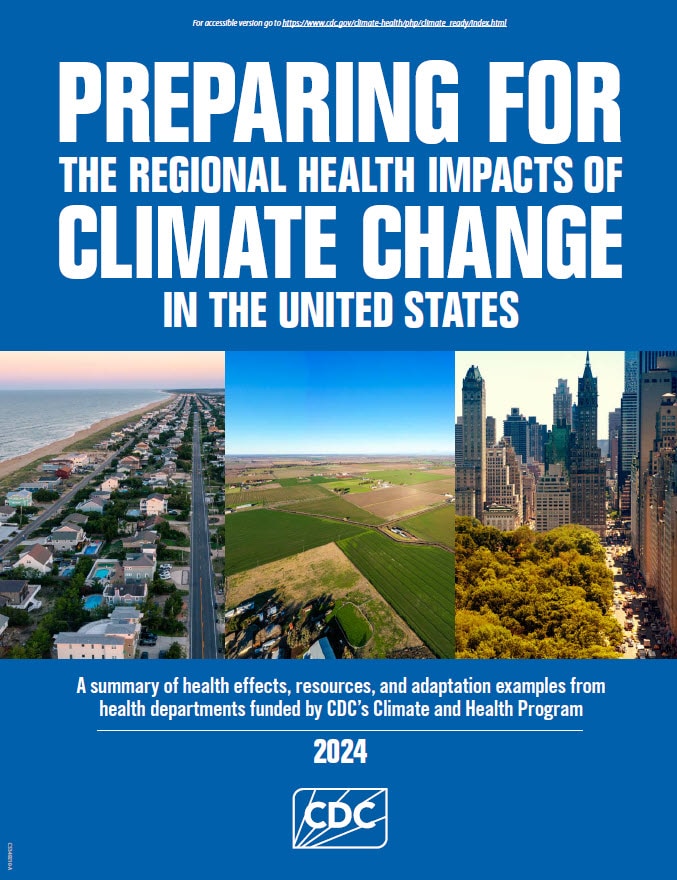At a glance
Each region of the United States experiences climate change and its impacts on health differently, due to the regions' location-specific climate exposures and unique societal and demographic characteristics.

Executive summary
The Centers for Disease Control and Prevention's (CDC) Climate and Health Program supports states, counties, cities, Tribes, and territories to assess how climate change will affect their community, identify populations more vulnerable to climate change, and implement adaptation and preparedness strategies to reduce the health effects of climate change. This document describes the various health impacts climate change will have on different regions of the United States. Unless otherwise noted, the material in this document is based on the cumulation of information from the U.S. Global Change Research Program, such as the Fifth National Climate Assessment (NCA5), Fourth National Climate Assessment (NCA4), and 2016 Climate and Health Assessment.
Background
Climate change, together with other natural and human made health stressors, influences human health and disease as some existing health threats will intensify and new health threats will emerge (https://www.cdc.gov/climate-health/php/regions/index.html). For example, changes in temperature and precipitation are increasing health risks associated with wildfire and ground-level ozone pollution. Rising air and water temperatures and more intense extreme events are expected to increase exposure to waterborne and foodborne diseases, affecting food and water safety. With continued warming, cold-related deaths are projected to decrease, and heat-related deaths are projected to increase, and in most regions, increases in heat-related deaths are expected to outpace reductions in cold-related deaths. The frequency and severity of allergic illnesses, including hay fever, are expected to increase as a result of shorter winters and earlier and longer pollen seasons. Climate change is also projected to alter the geographic range and distribution of insects and pests, potentially exposing more people to ticks and mosquitoes that carry the agents that cause diseases like Lyme disease, Zika, West Nile, and dengue. Communities in the Southeast, for example, are particularly vulnerable to the combined health impacts from heat and flooding, which can result in large populations of nuisance mosquitoes and potential disease risk. Finally, extreme weather and climate-related events can have lasting mental health consequences in affected communities, particularly if they result in degradation of livelihoods or community relocation. For more information on the health impacts of climate change in the United States, see the health chapter of the fifth National Climate Assessment: https://nca2023.globalchange.gov/chapter/15/
Importantly, not everyone is equally at risk. The impacts on health due to climate change are both place-specific and path-dependent as there are varying degrees of climate exposure and differences in individual and societal characteristics that can either protect you or make you more at risk to the impacts of climate change. For example, those that are overburdened and disproportionately affected by the health impacts of climate change include pregnant people, people other than cisgender straight men, older adults, children, communities with lower socioeconomic status, people with chronic illnesses, people living with disabilities, people experiencing homelessness, and racial and ethnic communities, such as Black, Indigenous, Asian, Latino/Hispanic, and Middle Eastern, commonly referred to communities of color or BIPOC. Adaptation and mitigation policies and programs help individuals, communities, and states prepare for the risks of a changing climate and reduce the number of injuries, illnesses, and deaths from climate-related health outcomes. CDC's Climate and Health Program is the national leader in empowering communities to protect human health from a changing climate. Beginning in 2010, the Climate and Health Program implemented the Climate-ready States and Cities Initiative (CRSCI) to help state and city health departments prepare for and respond to the health effects that a changing climate may bring to their communities. As of 2024, thirteen jurisdictions are directly funded to implement the five-step Building Resilience Against Climate Effects (BRACE) framework to identify likely climate impacts in their communities, potential health effects associated with these impacts, and their most at-risk populations and locations so that they can then develop and implement health adaptation plans and address gaps in critical public health functions and services. For more information see: https://www.cdc.gov/climate-health/index.html.
The Climate and Health Program also supports Tribes, territories, and other communities that are not part of the Climate-Ready States and Cities Initiative (CRSCI) through the "Building Capacity of the Public Health System to Improve Population Health through National, Nonprofit Organizations'' program managed by CDC's National Center for State, Tribal, Local, and Territorial Public Health Infrastructure and Workforce. Funded partners include the National Indian Health Board (NIHB) Climate-Ready Tribes Initiative; the Association of State and Territorial Health Officials (ASTHO) Climate-Ready Territories Initiative; the Council for State and Territorial Epidemiologists (CSTE); the National Environmental Health Association (NEHA); and the National Association of County and City Health Officials (NACCHO).
Region
Outlined on the following pages are the unique climate-related health impacts for each region of the United States (as defined by the Fifth National Climate Assessment) and relevant highlights of actions taken by the CDC Climate and Health Program's health department partners to prepare for and respond to climate change in their communities. Unless otherwise noted, the material in this document is based on the cumulation of information from the U.S. Global Change Research Program, such as the Fifth National Climate Assessment (NCA5), Fourth National Climate Assessment (NCA4), and 2016 Climate and Health Assessment. The climate impacts described in each region of this document are not comprehensive, though provide a high-level overview of key risks. This document synthesizes the impacts that are directly health-relevant but is not meant to be all-encompassing. In addition, a variety of climate-relevant health adaptation activities that are not funded by CDC are taking place across the country and are not reflected in this document.
